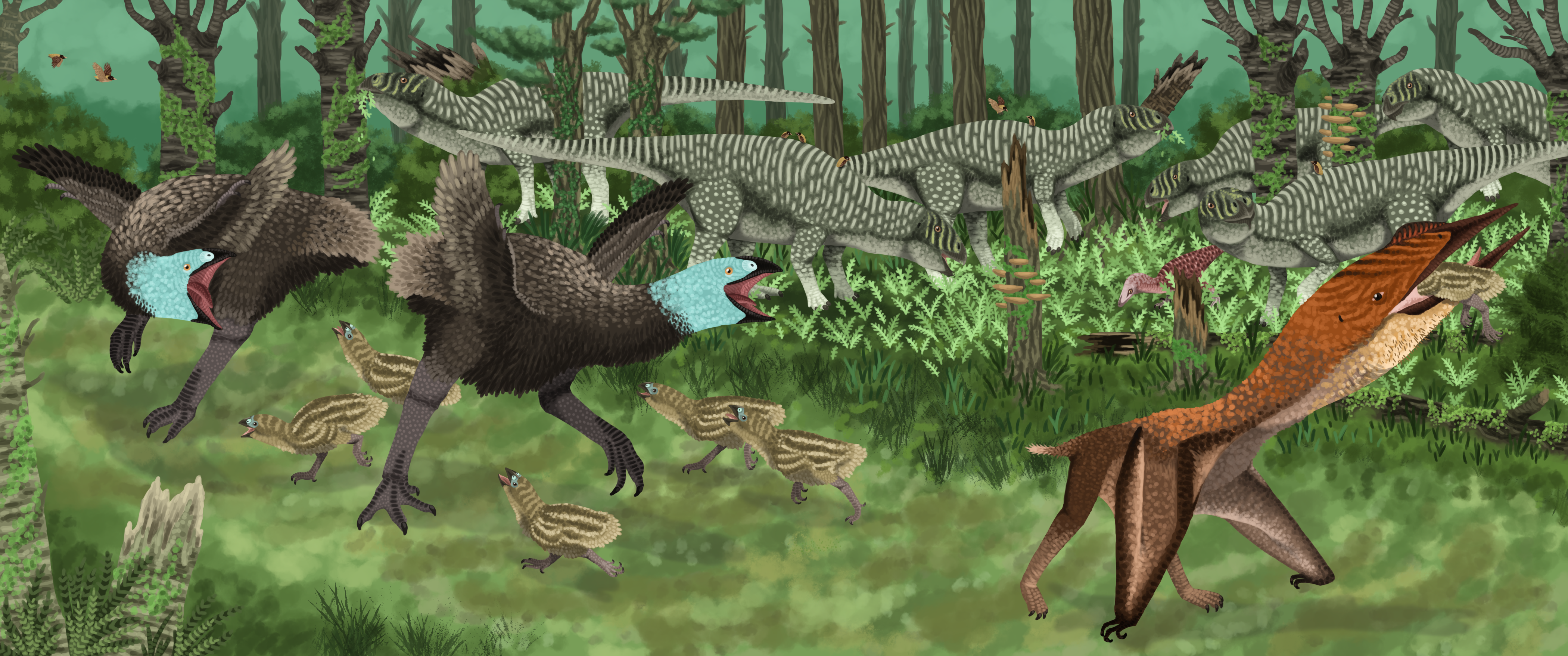HOME | DD
 TrollMans — Dine and Dash
TrollMans — Dine and Dash

Published: 2018-05-20 09:30:22 +0000 UTC; Views: 21982; Favourites: 378; Downloads: 43
Redirect to original
Description
Always remember to watch your kids closely, or else a large pterosaur might try and eat one when you're not paying attention. Or be like Rhabdodon and don't have kids to worry about at all.---
Early Maastrichtian (70 MYA), Southern France
Animal species:
Gargantuavis philoinos (wine-loving Gargantua bird)- a type of giant flightless avialan known from the early Maastrichtian of France and Spain, which at the time was part of an isolated landmass known as the Ibero-Armorican Island. The species is known only from a few hip, femur, and one probable neck bone (some of the egg fossils known from the region may belong to Gargantuavis, but it's considered more likely they are titanosaurian), but they seem to correspond to a very large terrestrial bird; comparisons to modern birds suggest it may have reached the size of a cassowary or ostrich, possibly weighing over three-hundred pounds (140 kg). Gargantuavis shares a few apparent similarities to the unrelated moas (also large, flightless birds that evolved in an insular environment), with a broad hip that suggests they were rather robustly built and weren't very quick, and a similar growth pattern of fast early growth followed by a longer period of slow cyclical growth, (rather than a single period of rapid growth to adult size seen in most modern birds) possibly an adaptation to the seasonal island environment. However, while moas lived on relatively predator-poor islands, Gargantuavis coexisted with numerous types of terrestrial predators; remains of dromaeosaurs, abelisaurids, crocodyliformes, and azhdarchids are known from the same fossil formations as Gargantuavis. It also coexisted with numerous types of herbivorous non-avian dinosaurs, although the exact implications of Gargantuavis within its ecosystem are yet unknown due to the fragmentary nature of its known fossils. The reconstruction here is extremely speculative for the same reason.
Rhabdodon priscus (ancient fluted tooth)- a species of medium-sized (reaching around four to six metres in length) iguanodont from the Campanian and Maastrichtian stage of Europe, with fossils known from France, Spain, and Romania (and possible remains known from the Czech Republic). Its fossils are very common (in contrast to Gargantuavis fossils, which are rare and isolated), suggesting it was a major herbivore of Europe during the Late Cretaceous, and a contemporary to its smaller close relative Zalmoxes. The species seems to have been largely replaced by hadrosaurids in Europe by the late Maastrichtian, although undescribed species of Rhabdodon seem to have made it to the very end of the Mesozoic nonetheless. Also according to the "A Dinosaur A Day" tumblr, was possibly preyed upon by Ampelosaurus... okay, whatever you say ADAY.
Pyroraptor olympius (Olympic fire thief)- a species of dromaeosaur reaching about the size of a small turkey known from the early Maastrichtian of France (supposedly, possible remains are also known from Spain). Only known from fragmentary remains of a few foot and arm bones, teeth, and vertebrae; probably due to this, its position among the dromaeosaur family tree is unclear (most dromaeosaur fossils from Europe are pretty terrible to be honest... Pyroraptor is just par for the course). Its name comes from the fact the type specimen (and only definite specimen so far) was discovered after a forest fire, which is probably the only particularly interesting fact about Pyroraptor.
Unnamed azhdarchid- fossils of azhdarchid pterosaurs are extremely common worldwide during the Late Cretaceous, ranging from animals as tall as giraffes to forms little larger than cats; most are believed to have been terrestrial predators. The species depicted here is hypothetical (fossils of azhdarchids are known from the same time and region as the other species however), but based on an unnamed relatively short-necked species from Hațeg Island (knowing the probable soaring capabilities of azhdarchids, it wouldn't be surprisingly if Hațeg species were also found in other regions).
Indeterminate enantiornitheans- lil birdies, very common during the Cretaceous Period, but died out at the end of the Mesozoic. Not much else to say about these, just small generic birds (remains of unidentified enantiornitheans are known from the region so they have some basis in reality at least).
---
Initial intent of this drawing was to show some more bird (or avialan at least) and pterosaur interaction... they did coexist for something like a hundred million years, they probably noticed one another at least one or twice during that period, but that's just me guessing wildly, don't quote me on it.
Related content
Comments: 16

Or it could be because, like most early birds, it didn't have parental care: onlinelibrary.wiley.com/doi/ab…
👍: 0 ⏩: 0

Very nice, I specially liked how you didn't make Gargantuavis just ratite like.
That said I have one minor complain, I don't know if it been published, but some recent research seems to indicate Rhadbdodontids were stricts bipeds.
👍: 0 ⏩: 1

Yeah, I didn't know that when I drew this, but if I ever end up drawing rhabdodontids again I'll remember that fact next time.
👍: 0 ⏩: 0

Good Glory, if this were any more lush you could use it to advertise hair conditioner!
👍: 0 ⏩: 0

I really like your interpretation of Gargantuavis
👍: 0 ⏩: 0

If an adult Hatzegopteryx shows up it could eat an adult Gargantuavis.
👍: 0 ⏩: 3

So what happens to Isle del mundo period, will you continue, Becasue I really love that project, including Diyu. Also big Fan
👍: 0 ⏩: 0

Why? Because an adult Hatzegopteryx is much larger (in mass) than Gargantuavis-it would be like a marabou stork dealing with a flamingo.
👍: 0 ⏩: 0

Damn, really loving the art style here! Also, really nice to see Gargantuavis getting the attention it deserves.
👍: 0 ⏩: 1

Your work is great. : )
👍: 0 ⏩: 0

Great scenery, Gargantuavis is still a rare sight these days!
👍: 0 ⏩: 0

Looks great! The texture on those feathers in particular is really nice
👍: 0 ⏩: 0




























